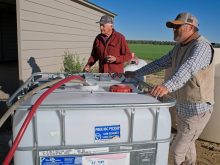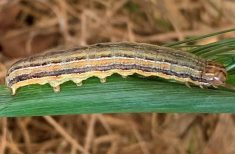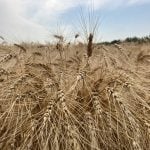Glacier FarmMedia — Grasshoppers, as their name suggests, hop from place to place in grassy fields.
Taking advantage of that natural behaviour, University of Wyoming scientists have devised a way to control grasshoppers on pastures with smaller volumes of pesticides.
The method is called Reduced Agent and Area Treatments (RAAT), in which farmers apply an insecticide to one strip on a pasture, leaving the adjacent strip unsprayed. That alternating pattern continues across the field, so only half the pasture receives insecticide.
Read Also

Cancer agency reclassifies another herbicide ‘probably carcinogenic’
The WHO’s cancer research agency has now put atrazine, a herbicide well known to corn growers, in the same potential-hazard category where the agency put glyphosate.
The research shows it’s possible to reduce insecticide by 50 per cent and still kill most of the hoppers.
“You can get 80 to 90 per cent control doing this because grasshoppers do move around and some do move around quite a bit,” said John Gavloski, an entomologist with Manitoba Agriculture.
Gavloski shared information about the RAAT method during a Saskatchewan Ministry of Agriculture webinar on grasshoppers and grasshopper control earlier this spring. The basic idea is that grasshoppers will jump into the treated strips.
“The RAATs strategy is effective for grasshopper suppression because the insecticide controls grasshoppers within treated swaths while conserving natural grasshopper predators in swaths not directly treated,” says a U.S. Department of Agriculture report on grasshopper suppression.
The U of Wyoming scientist who did the research on RAATs provided a similar explanation to Wyoming Livestock Roundup, a weekly publication in the state.
“RAAT takes advantage of the insect’s behaviour,” said Scott Schnell, in 2019. “Nymphs and adults alike move around a lot in search of food, so even if we don’t kill them with the initial application, they will likely move to a treated strip in search of food… Because they eat so much, they will likely consume a plant that has been sprayed.”
A U of Wyoming website explains how farmers can employ the strategy.
One option for spraying a pasture in alternating strips is with an ATV. The vehicles are well suited for the gopher holes and bumpy terrain of a pasture and can be equipped with a sprayer.
The U of Wyoming estimates this approach can reduce costs by 70 per cent compared to blanket coverage because it requires a smaller volume of insecticide and less time to spray the pasture.
Some Canadian ranchers may have experimented with RAATs to control grasshoppers on pastures and some farmers have also used the technique on annual crops, Gavloski said.
“I know, anecdotally, that people have been doing it in wheat, canola and some of our other crops… People think they get good results, but it hasn’t been researched in those crops.
“Unfortunately, this technique has only been (studied) in a pasture/rangeland situation. I’m trying to encourage our researchers to duplicate these experiments in some other field crops… in our Canadian Prairie conditions.”
During the webinar, Gavloski encouraged farmers to control grasshoppers early in the season. Waiting for them to develop into adults is a mistake.
“We don’t want you to get to that point that you’re trying to battle adult grasshoppers. The adult grasshoppers are moving around. You need higher rates… some products don’t work against them.”
A Manitoba Agriculture document contains more information on grasshopper monitoring and management.
It says the nymph stage is the optimal time to kill grasshoppers, before their wings develop.
“Insecticide applications are most effective and the costs are lower … while the nymphs are still concentrated in their breeding areas,” Manitoba Agriculture says.
“It is generally best to control grasshoppers when the majority are in the third to fourth nymph stages. The lowest dosage given on the insecticide label should be used when the grasshoppers are small and the vegetative cover is low.”
















